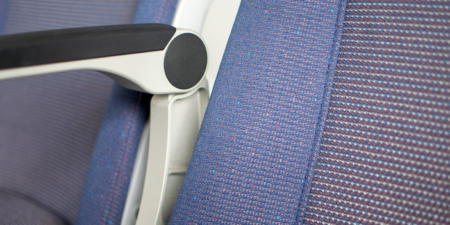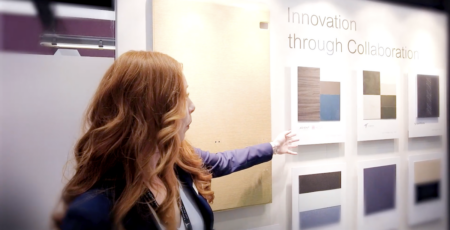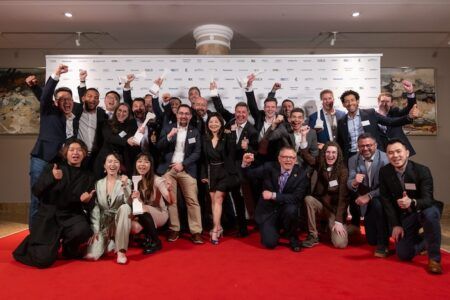Simona Boltaron has launched 9815N, a new FAR-rated high-impact sheet developed for use in 2D or 3D thermoformed aircraft interior seat parts that can withstand UV-C cleaning.
Boltaron 9815N was engineered to be the next generation of the company’s high-impact thermoplastic product, 9815E, with a formulation that enhances its ability to withstand regular ultraviolet-C (UV-C) disinfection routines. UV-C cleaning is a practice frequently used in healthcare applications and is expected to be more frequently utilised in aircraft interiors to help ensure cabin hygiene.
To verify the results, Simona Boltaron collaborated with GermFalcon, the manufacturer of the first UV-C system designed for aircraft cabins. The GermFalcon machine kills bacteria and viruses using hospital-proven doses of UV-C light to disinfect surfaces.
In an independent test by GermFalcon, Boltaron 9815N samples were tested to understand its performance after long-term UV-C exposure. Several factors were observed, including colour changes, bending properties and impact resistance. The samples were exposed to doses of exposure equal to 1-6 years of UV-C exposure, according to the companies.
GermFalcon used Dimer Protocol 62-4c, which is a test protocol for UV-C exposure effects on surfaces after six years.
“To achieve a 99.99% germicidal rate, an average 10.0 mJ/cm2 UV-C dose is anticipated. One year of daily GermFalcon use causes approximately 3,650 mJ/cm2 UV-C exposure. A 10% safety factor brings the annual exposure of 4,000 mJ/cm2 (minimum) at the surface tested,” said Simona Boltaron in a statement.
Samples of 9815N were placed under the UV-C chamber lamps, which were powered until the cumulative dose on the exposed band reached 4,000 mJ/cm2, corresponding to 12 months of UV-C exposure. The lamps were then shut down. The mask was next moved to expose the ‘5’ and ‘6’ horizontal bands. The chamber’s lamps were powered until the cumulative dose reached 4,000 mJ/cm2. This exposed the ‘5 band to 4,000 mJ/cm2 and the ‘6’ band to a total 8,000 mJ/cm2. Successive bands were exposed to 4,000 mJ/cm2 and the mask moved to the next lower number. The ‘0’ band was not exposed to UV-C.
At the conclusion of the test, the Boltaron 9815N samples were observed in open daylight with levels of >3,000 lux to detect and emphasise colour changes.
According to Simona Boltaron, the 9815N test samples showed no visible changes over the equivalent of six years of UV-C exposure, with the tactile feel of the thermoplastic, as well as its bending properties appearing unchanged, with no cracking.
“Our research and development teams dove right in to come up with a material formulation that would provide the long-term performance and durability that our customers can rely on as they ramp up their cleaning frequency and techniques,” said Kevin Asti, president of Simona Boltaron. “Understanding the cleaning technologies that are available to the aircraft interiors industry, such as GermFalcon, and how they interact with our materials is critical to that process.”
9815N is claimed to be safe to clean using all aviation interior cleaning products, including those that contain quaternary ammonium salts, with no adverse effects to the appearance of the material. These cleaning products include, but are not limited to:
• Callington Aero Glass Cleaner (ethanol)
• Callington CH2200 (ethanol, alcohol solvent)
• Celeste Biozyme EX3 (bacillus spores)
• Celeste MicroGreen AGR (d-limonene)
• Celeste SP-NG85000 Interior Cleaner Complete (alcohols, ethoxylated)
• Celeste Sani-Cide 32 (ammonium chloride quat)
• Celeste Sani-Cide EX3 (lactic acid)
• Celeste Sani-Cide FSC (ammonium chloride quat)
• Celeste San-Com (ethanol)
• Clorox Disinfecting Wipes
• Dawn Dish Soap and water
• Frasers Bacoban for Aerospace (quaternary ammonium salts)
• Lysol Clean and Fresh Multisurface Cleaner Sparkling Lemon Scent
• Lysol Dual Action Wipes Citrus Scent
• Palmolive and water (ammonium lauryl sulfate isodecyl alcohol ethoxylate)
• Real Clean AeroCide Aircraft Interior Disinfectant
• Zip-Chem Calla 7127
• Zip-Chem Calla 1452
• Zoono Microbe Shield
• Isopropyl Alcohol (70%)
• Clorox Bleach
Boltaron 9815N is available in custom colours and a wide range of textures to allow for design flexibility, as well as regulatory compliance.





